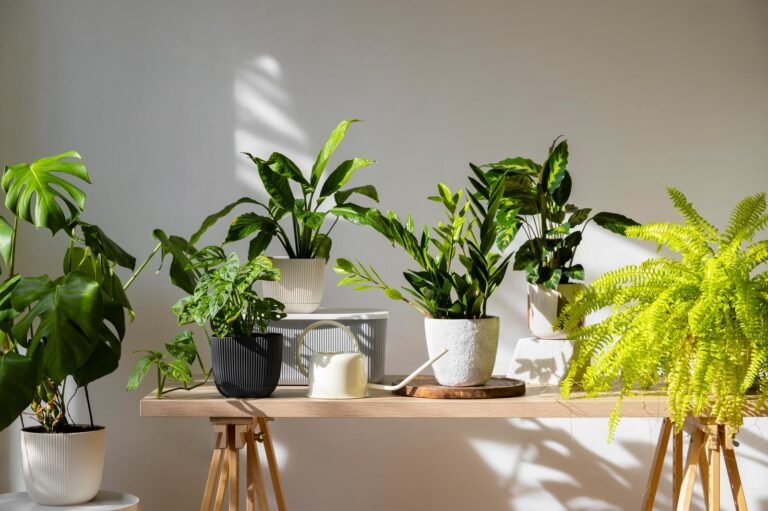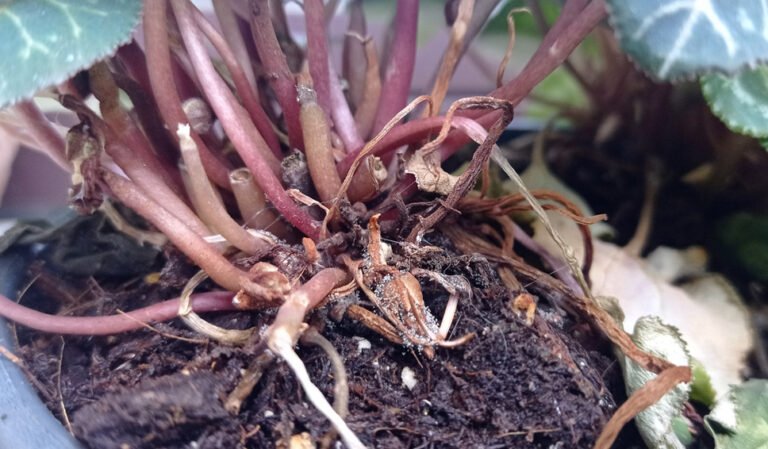If you are a garden lover and are planning a trip near London, don’t miss the unique opportunity to visit Kew Gardens, formally Royal Botanic Gardens, a spectacular botanical garden site of an ancient royal estate in the London borough of Richmond upon Thames, a UNESCO World Heritage Site since 2003, where landscape design, architectural heritage and botanical collections combine to form a unique testimony to developments in garden art and natural sciences.
Since their creation in 1759 at the behest of Princess Augusta, mother of King George III, this historic landscape area features elements that illustrate significant periods of garden art from the 18th to the 20th century, in which past, present and future are closely intertwined, giving a relevant and uninterrupted contribution to the study of plant diversity, systematics as well as ecology since it is closely associated with scientific and economic exchanges in the field of botany as emerges in the richness of its collections which represent a point of reference for scholars from all over the world.
The influence of Kew Gardens in the horticultural and plant classification sphere spread internationally as early as the 18th century: during numerous explorations the first English botanists collected plant specimens all over the world to keep them safe in this place that is today recognized as a global center of excellence for scientific research and education in the study of plants and fungi with botanical collections, including herbariums and living plants, enriched over the centuries, specimens of which have been used to create new botanical gardens around the world. A continuous exchange of cultural and scientific knowledge also emerges from the landscape and architectural characteristics of the gardens which reflect notable artistic influences both from the European continent including the most remote areas.
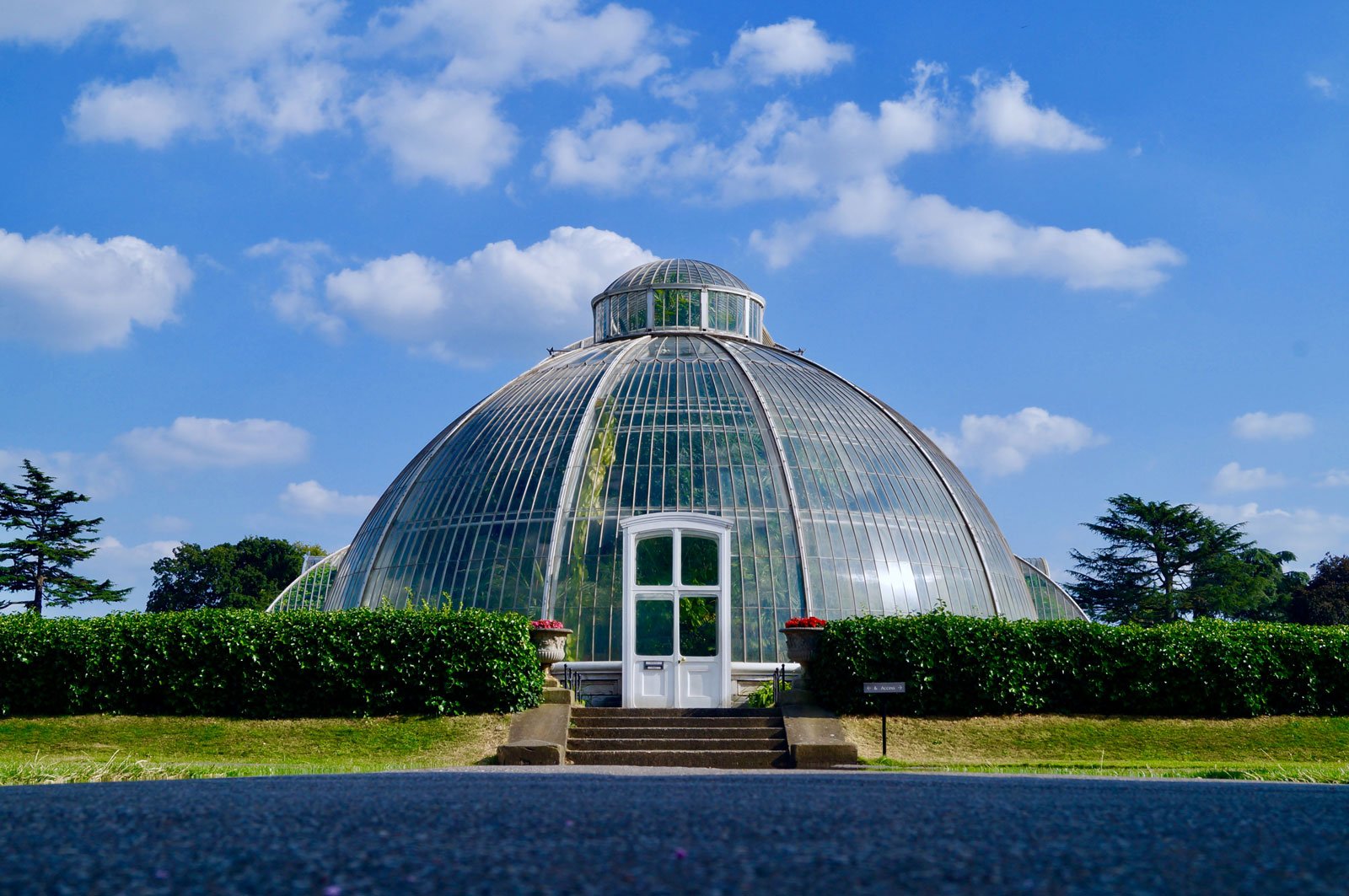
Just thirty minutes from central London, the gardens extend over 120 hectares featuring more than 50,000 species of native and exotic plants from many different biomes, and works by landscape architects such as Charles Bridgeman, Lancelot ‘Capability’ Brown and William Nesfield.
Let’s now begin to activate our senses by being led along wide paths in the heart of Kew, along the boundaries of a 320 meters double herbaceous border, colored and punctuated by bulbs, the Great Broad Walk Borders, which lead us to the lake and the Rose Garden through a spectacular range of cultivars and wild species where rudbeckias, geraniums, salvias, lavender, mulleins, phlomis, pennisetum and mischantus stand out distributed in eight flowerbeds whose color shades evolve over the seasons. So here we are at the Rose Garden, a fantastic rose garden designed by the architect landscape designer William Nesfield in 1848 and which today boasts 170 species and cultivars, where you can be inebriated by colors and scents.
We go on our route, maybe meeting some playful squirrels, along the Lake crossing, a bridge, installed in 2006, with curved and soft lines in black granite that leads us over the waters of the lake, created in 1856, with an area of about five acres of water, dotted with four small islands full of trees whose foliage colors change in autumn, reflecting in the waters and creating spectacular sceneries with red, orange and yellow chromatic shades.
We walk peacefully and here we find ourselves looking at one of the two iron greenhouses called Palm House, an extraordinary rainforest covered with tropical plants, some of which are in danger of extinction in their natural habitats and others of significant value and global economic importance such as the African oil palm or cocoa tree. Below the greenhouse, in the basement, there are the remains of the railway tunnels used to transport the fuel for heating the structure itself. A few steps away we immerse ourselves along the slopes lined with maples, birches, lindens and oaks through the Woodland Garden, designed to recall the habitats of the temperate mountains, in an ecological balance where the trees protect herbaceous species such as hellebores, primroses and bluebells. From here we come to the Temple of Aeolus, designed by William Chambers, first built in 1760 and then rebuilt in 1845, which offers views to the north-west over the surrounding woods. Continuing our journey we will be fascinated by another greenhouse on which the entire area called Temperate House is centered, the largest Victorian greenhouse in the world, a kind of botanical cathedral which around 1200 species from temperate regions kept in it, representing today a treasure and a reference point for biodiversity preservation.
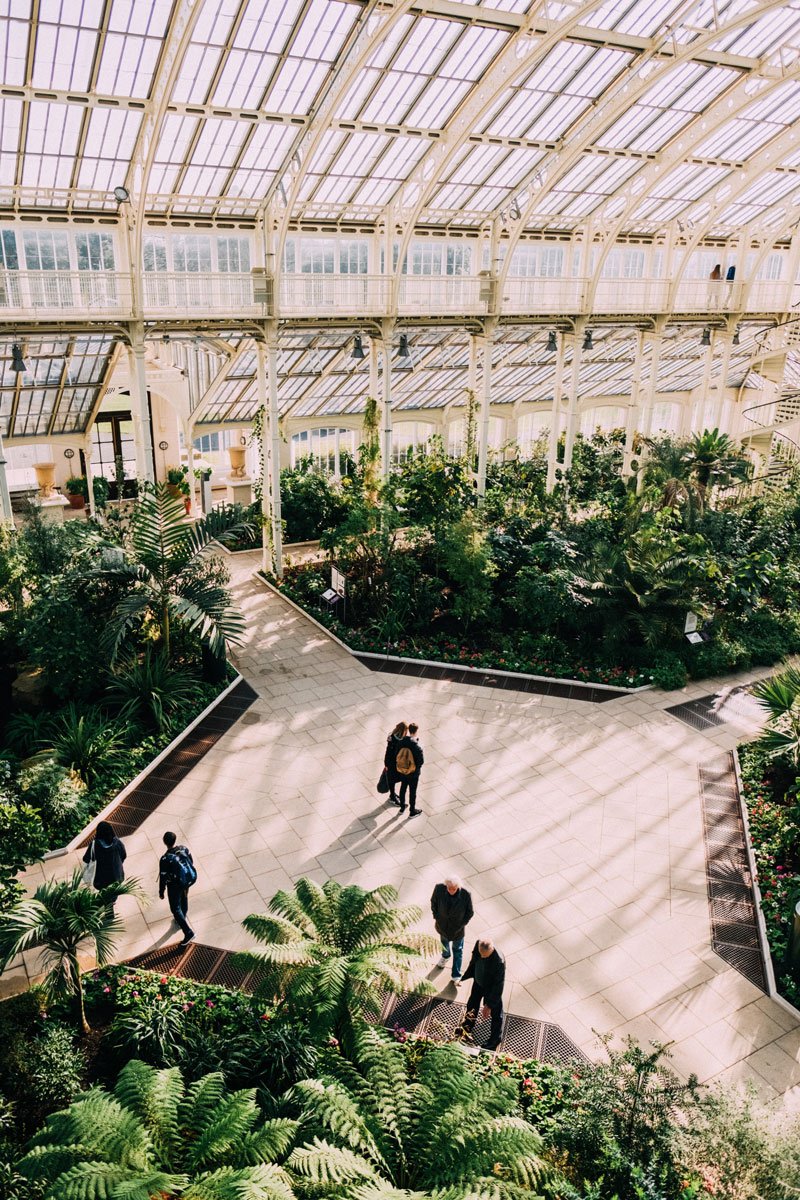
And now? How can we not visit Rhododendron Dell where we can admire a rich collection of rhododendrons which includes unique hybrids in the world through woodchip paths, and if we were to plan our trip in April or May we could also be the protagonists of an explosion of their intensely colored petals. Let us then be captivated by the arboretum with its collection of 14,000 trees belonging to over 2000 species, constantly evolving thanks to the propagation work carried out directly in the internal nursery, in a living landscape that extends over two thirds of the gardens where you can experience the beauty and the diversity of forests around the world, remaining astonished in front of specimens that date back to the 18th century such as Quercus x hispanica ‘Lucombeana’ or in front of the 40 meter high sequoia.
We also go to enjoy spectacular views of the city of London from the peaks of the Great Pagoda, completed in 1762 in honor of Princess Augusta, founder of the Gardens, whose restoration was completed in 2008. It represents one of the oriental-style buildings designed for Kew by William Chambers, who traveled extensively in China where he found inspiration from the architecture and gardens he visited.
For young visitors here is the Children’s Garden, a large space with over 100 trees, fun and interactive, where they can explore, understand how a plant is born and learn the vital role of the water cycle, climb, run, jump, walk along the elevated walk wrapped around the large 200-year-old oak, and even walk through a tunnel of living bamboo and a jungle of palm trees, admire colorful giant flowers, walk along winding paths and observe the water games in the stream in a true sensorial adventure. For the older ones, but also for the little ones, we take the opportunity to visit the collection of carnivorous plants from Australia and Brazil inside the Princess of Wales Conservatory structured in ten climatic zones that lead us through a series of ecosystems such as that of the arid deserts, where you can admire cacti and other succulents, or the humid tropics with orchids and bromeliads. Hidden in the foundations of the Conservatory is a capsule, left in 1985 by David Attenborough, containing seeds of food crops and endangered species, which will be displayed in 2085!
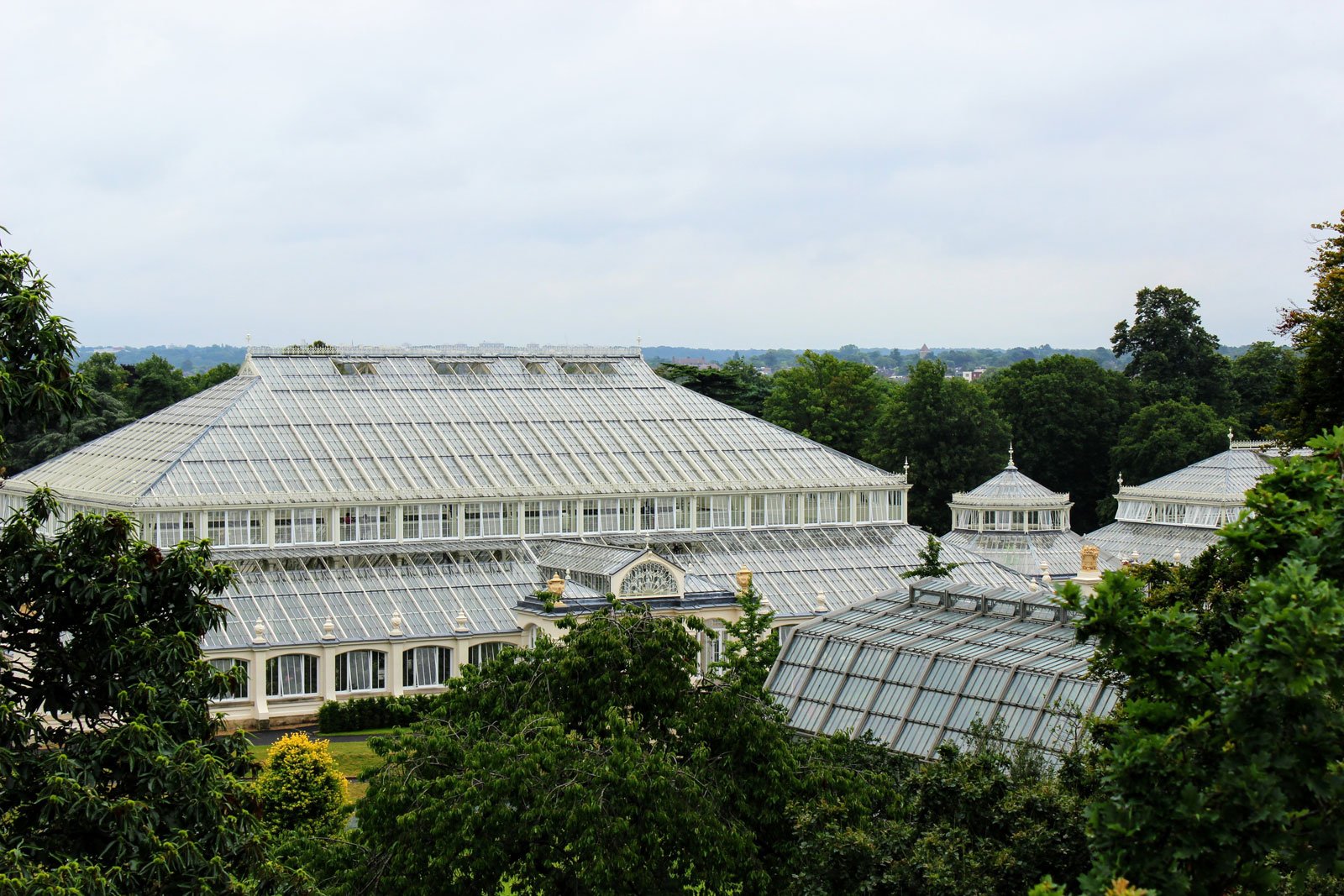
Bonsai enthusiasts will find a fascinating collection in the Bonsai House with around 60 small trees belonging to the Juniperus, Acer and Prunus botanical genera, cultivated using the techniques of ancient Japanese art, with unique specimens such as the Juniperus over 180 years old. Nearby we also find Davies Alpine House inaugurated in 2006 and designed by combining traditional and modern technologies in order to recreate the environmental and climatic conditions typical of alpine plants, able to survive in habitats with extreme temperatures such as at the poles or along the mountain tops, from the Alps to the Andes to the Arctic. Davies Alpine House is located in the one-acre valley of the Rock Garden, carved into the sandstone landscape and framed by spectacular waterfalls, home to wild plants native to mountainous regions throughout the world and grown directly from seed in a unique setting that reflects the wild alpine landscape. In a few minutes we will have the opportunity to move from the mountain environment to the Mediterranean one of the Mediterranean Garden, an area created in 2007 which reflects the typical natural habitat of southern Europe with rockroses, lavender, olive trees, cypresses and in the center of which stands the King William’s Temple, built in 1837 in memory of William IV, one of 44 protected monuments at Kew which reflect the stylistic expressions of various periods while maintaining their authenticity in terms of design, materials and function.
Another recommended stop: the Japanese gardens, modeled in a unique landscape and correlated with the Japanese portal, the Chokushi-Mon, represent a scrupulously cared place of peace, harmony and reflection, like all Kew Gardens, with the typical Japanese tea garden, paths, raked gravel, large rocks and shrubs such as rhododendrons. Still on the theme of the East, we can immerse ourselves in the Bamboo Garden, the largest collection in the United Kingdom with about 130 species of bamboo originating from China, Japan, the Himalayas and America, where the foliage and growth of the numerous varieties create a vibrant and deep landscape which leads us to Minka House, the common home of the inhabitants of the countryside of Japan up to mid-20th century, donated in 2001 to Kew and rebuilt by a team of Japanese and British craftsmen, becoming a symbol of architectural heritage.
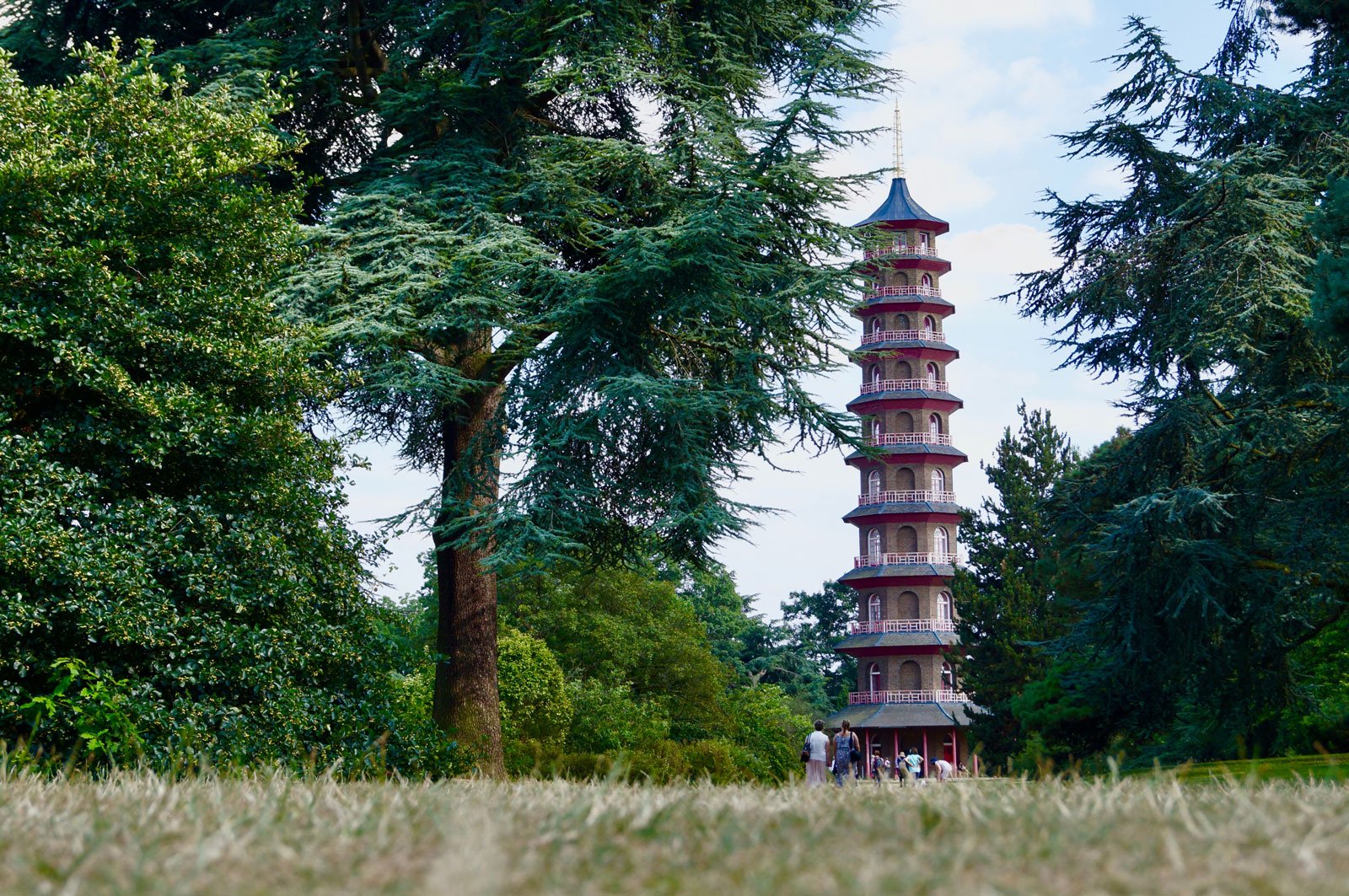
Do you want to relax? So let’s head to the natural area with 37 acres of woodland with trees, shrubs and herbaceous plants on the border with the Thames where a wild and uncontaminated landscape opens up, at the request of Queen Victoria herself who donated the area providing that it remained in its natural state, where you can walk along a raised path, called Woodland Walk, built in harmony with the surrounding space, which leads us towards a carpet of bluebells that envelops Queen Charlotte’s Cottage, summer residence, together with Kew Palace, of King George III, of his wife Charlotte and their children in the 18th century, or allows us to get closer to the bug hotels where adults and children can observe the numerous insects that populate the area in a perfect ecosystem balance with trees such as beech, ash, oak and pine, some of which were knocked down by atmospheric events such as storms and transformed into a trunk path intended for children.
Garden and cooking lovers cannot miss a visit to Kew’s Kitchen Garden, an area where numerous varieties, including recently introduced ones, of fruit trees and horticultural species are grown following the principles of crop rotations and avoiding the use of chemicals for plant defense through plant intercropping. Are you starting to feel hungry? No problem, Kew Gardens offers a wide variety of bars and restaurants, one of which is housed in the spectacular Orangery, supplied directly with products from the vegetable garden and orchard, in short, zero kilometer!
If you are researchers or lovers of reading then enter the library and archive where almost 2000 years of knowledge are preserved with continuously updated information on the classification and use of plants, plant ecology, botanical gardens and herbaria of all the world as well as relating to the history of gardens and their design.
The Royal Botanic Gardens still offer much, such as the Queen’s Garden dedicated exclusively to plants and architectural styles of the 17th century, or the Grass Garden with around 550 herbaceous, edible or ornamental species, and even Waterlily House, a small square greenhouse where you can admire aquatic plants including the gigantic Amazonian water lily called Victoria amazonica in honor of Queen Victoria and multiplied from seed every year. Let’s not forget the collection of 19th century botanical art that covers the walls of the Marianne North Gallery, or the Shirley Sherwood Gallery of Botanical Art, the first public gallery in the world dedicated to classical and contemporary botanical art.
Finally we can complete our day with a view of the gardens from above along the Treetop Walkway, an steel path raised 18 meters above the ground and with a thin design in perfect harmony with the surrounding environment that allows us to connect with nature by crossing the foliage and the branches of chestnut, beech, horse chestnut and oak trees.
Finally, I recommend informing you about the numerous activities organized throughout the year. I didn’t tell you that to get to the Royal Botanic Gardens is very simple: take the underground, get off at the Kew Gardens stop that is just 500 meters from the Victoria Gate entrance and enter this fantastic place.


